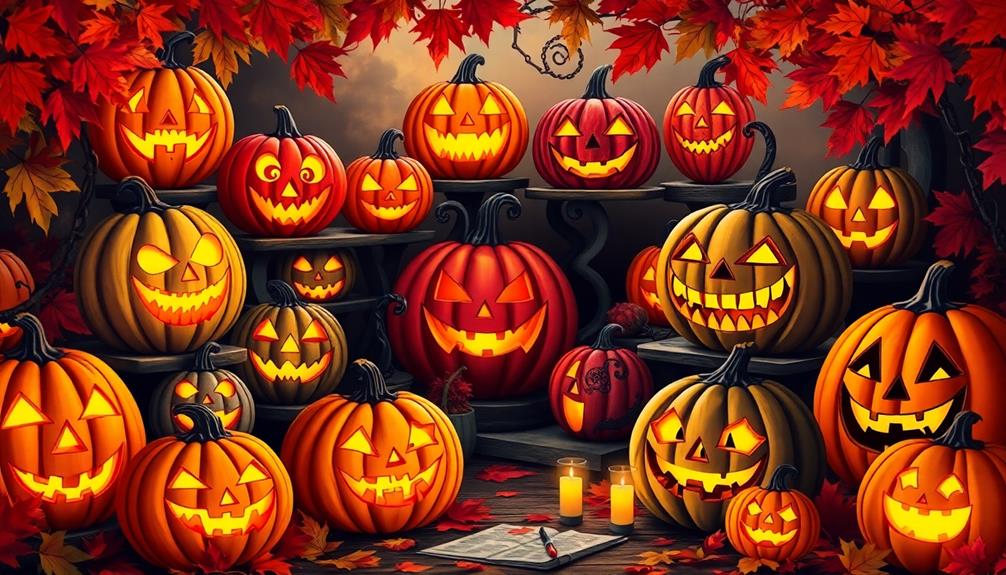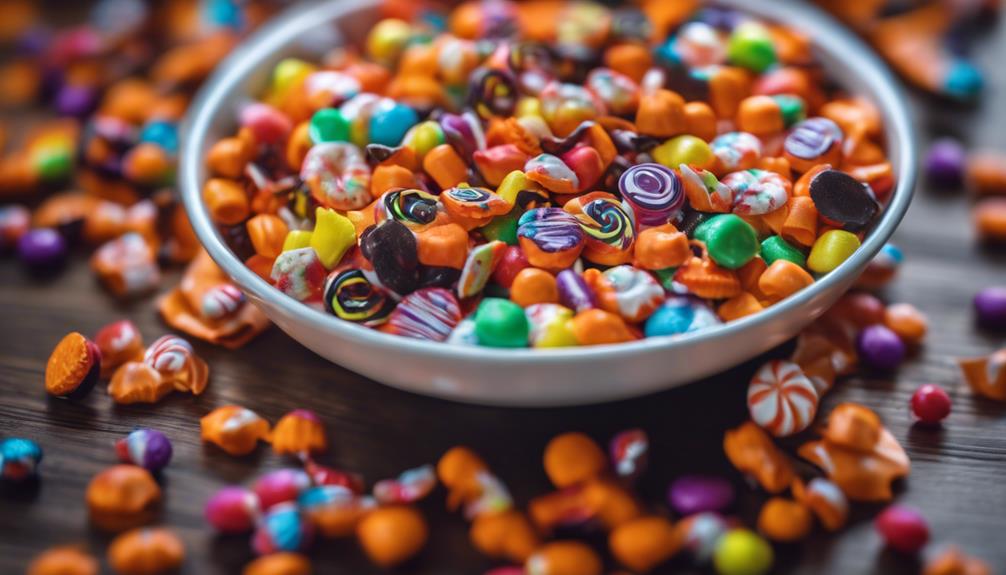Jack-o'-lanterns trace their roots back to ancient Ireland, where people carved scary faces into turnips during Samhain to ward off evil spirits, especially the tale of Stingy Jack. As Irish immigrants arrived in America, they switched to pumpkins, and by 1837, the term "jack-o'-lantern" was widely adopted. Today, you see them as symbols of Halloween, embodying themes of light overcoming darkness. Globally, they connect to various lantern traditions, celebrating remembrance and hope. If you're curious about how these customs evolved and their significance across cultures, there's much more to discover.
Key Takeaways
- Jack-o'-lanterns originated in Ireland during Samhain, where carved turnips were used to ward off evil spirits linked to the legend of Stingy Jack.
- Irish immigrants popularized pumpkin carving in America, leading to the modern tradition of jack-o'-lanterns in Halloween celebrations.
- The term "jack-o'-lantern" was first recorded in 1658 and became associated with carved pumpkins in American culture by 1837.
- Jack-o'-lanterns symbolize light overcoming darkness, reflecting universal themes of remembrance and hope across various global lantern traditions.
- Modern celebrations include pumpkin carving contests and community events, fostering creativity and engagement during the Halloween season.
Etymology and Historical Context
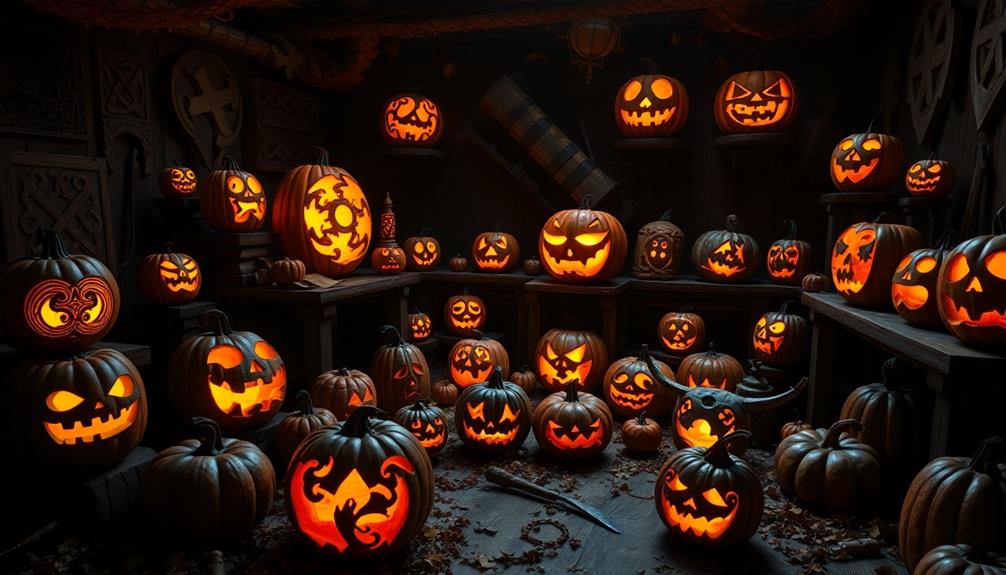
The term "jack-o'-lantern" has an intriguing history that dates back to the 17th century. Originally, it referred to ignis fatuus, or mysterious lights seen in marshes, with its first recorded use in Britain occurring in 1658.
It wasn't until 1837 that the term became specifically associated with carved vegetables, marking a notable shift as it began to embody the spirit of Halloween. This evolution mirrors the importance of cultural traditions and how they adapt over time, much like the concept of diversification in finance, where different elements come together to create a richer experience.
The tradition of carving jack-o'-lanterns is believed to have originated in Ireland, where people carved root vegetables like turnips and mangel wurzels during the Gaelic festival of Samhain.
This practice was linked to the story of Stingy Jack, a trickster who outsmarted the devil and roamed the earth as a wandering spirit. To ward off Jack's spirit, people began carving vegetables, which eventually evolved into the festive jack-o'-lantern we recognize today.
When Irish immigrants arrived in America, they brought this tradition with them. They discovered that pumpkins, being larger and easier to carve than traditional root vegetables, made for perfect jack-o'-lanterns, forever changing the Halloween landscape.
Folklore and Legends
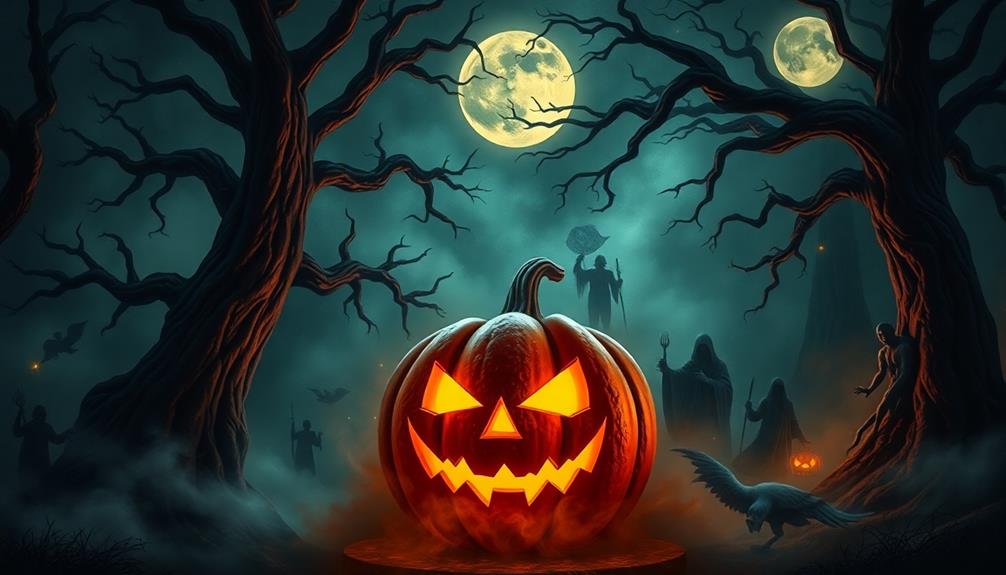
Carved from centuries of storytelling and tradition, jack-o'-lanterns are steeped in folklore that captivates the imagination. One of the most famous tales is that of Stingy Jack, an Irish figure who tricked the Devil and was condemned to roam the Earth with only a carved turnip lantern to light his way. This legend not only explains the eerie glow of the jack-o'-lantern but also reflects deeper themes of trickery and consequence in folklore.
In a similar vein, the enduring love and memory of a mother can also be honored through heartfelt tributes on special occasions like birthdays, ensuring that her legacy lives on in the hearts of her family members. a mother's enduring love
As Irish immigrants brought their traditions to the United States, they adapted the practice of carving root vegetables for Halloween, swapping turnips for the more accessible pumpkin. This transformation helped cement the jack-o'-lantern's place in American Halloween culture.
The flickering lights of these carved pumpkins evoke the ignis fatuus, associated with lost souls, linking back to Stingy Jack's tale.
Additionally, the jack-o'-lantern gained further popularity through Washington Irving's "The Legend of Sleepy Hollow," solidifying its status in American folklore.
Today, when you carve your jack-o'-lantern, you're participating in a rich tapestry of stories that connect the past with the present, celebrating Halloween's spooky charm.
Origins in Ireland

Originating in Ireland, the tradition of jack-o'-lanterns stems from ancient customs tied to the Gaelic festival of Samhain. This festival marked the end of the harvest season, and Irish families carved scary faces into turnips to ward off Stingy Jack and other evil spirits.
According to folklore, Stingy Jack tricked the Devil and was cursed to wander the Earth with a carved turnip, holding a burning coal to light his way. The act of carving, much like the emotional expression found in Hindi Rider Shayari, symbolizes a journey through fear and creativity.
In those days, carving turnips was a common practice in Ireland, Scotland, and England. However, when Irish immigrants moved to the United States, they found pumpkins to be more suitable for their jack-o'-lanterns. Pumpkins were larger and easier to carve, making them the preferred vegetable for this tradition.
The term "jack-o'-lantern" first appeared in the United States in 1837, reflecting how the practice evolved in American culture. As Irish immigrants continued to arrive, especially during the Great Potato Famine in the 1840s, they brought this rich tradition with them, ensuring that the legacy of jack-o'-lanterns originated in Ireland would flourish in new lands.
Adaptation in North America
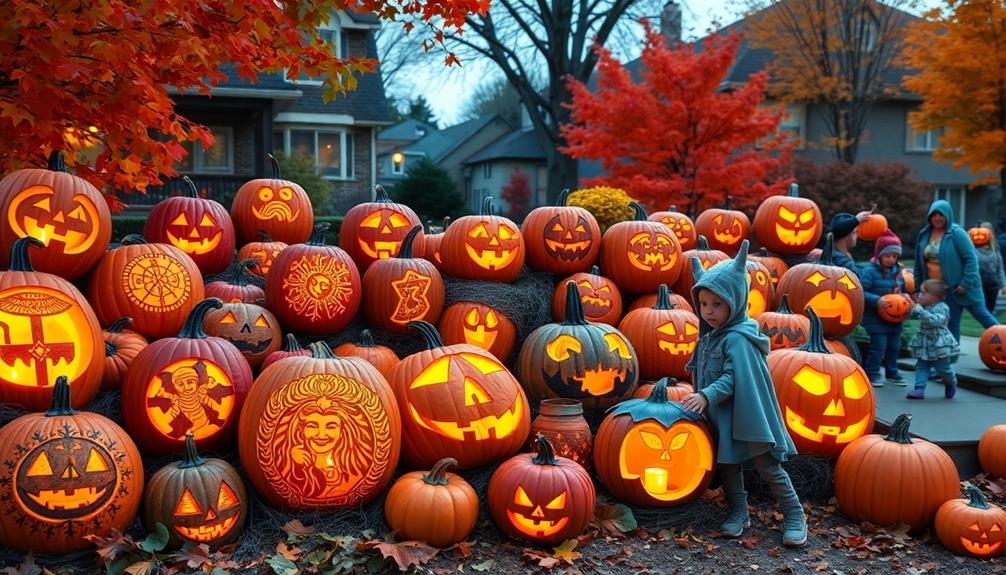
As Irish immigrants settled in North America, they adapted their jack-o'-lantern tradition to incorporate the more abundant pumpkins found in their new homeland. The origins of jack-o-lanterns shifted from turnips to these larger, easier-to-carve fruits, making them a staple in Halloween celebrations.
This adaptation mirrored other cultural changes where trust issues with boyfriends can arise when traditions evolve. By 1837, the term "jack-o-lantern" was officially applied to carved pumpkins in American English, marking a significant cultural shift.
John Greenleaf Whittier's poem "The Pumpkin," published in 1850, further popularized the image of carved pumpkins, intertwining them with Halloween festivities.
By the late 19th century, records from the Kingston Daily News in 1866 highlighted how carved pumpkins became prominent in American Halloween customs. The influx of Irish immigrants during the Great Potato Famine in the 1840s not only brought their traditions but also facilitated the widespread adoption of pumpkin carving for Halloween.
Today, you'll find that modern practices include using LED lights for safety in jack-o-lanterns, along with countless online tutorials and pumpkin carving competitions, ensuring that this beloved tradition continues to thrive as you celebrate Halloween with friends and family.
Carving Techniques and Materials

When you're ready to carve your jack-o'-lantern, choosing the right pumpkin type is essential for achieving the best results. Different varieties, like the Connecticut field pumpkin, offer the ideal size and thickness for easy carving.
For inspiration, you might consider some creative food ideas for toddlers, such as unique beetroot recipes, that can make the experience more enjoyable.
You'll also want to gather essential tools, from knives to specialized kits, to bring your creative designs to life.
Pumpkin Types Overview
Choosing the right pumpkin type is essential for successful jack-o'-lantern carving, especially if you want to create a masterpiece. The Connecticut field pumpkin is the most recognized type for jack-o'-lanterns, prized for its size, shape, and ease of carving. Here's a quick overview of popular pumpkin types to contemplate:
| Pumpkin Type | Characteristics | Best Use |
|---|---|---|
| Connecticut Field | Large, round, and easy to carve | Jack-o'-lanterns |
| C. maxima | Big size, ideal for decorations | Sculptures |
| C. pepo | Traditional carving pumpkins | Faces and designs |
| Miniature Pumpkins | Small and cute | Table decor |
| White Pumpkins | Unique color for creative designs | Modern art pieces |
When you carve these pumpkins, you'll typically cut a lid around the stem, scoop out the seeds and pulp, and then create your designs. Many modern carvers now use LED lights instead of candles, making it easier to illuminate your carved masterpieces while ensuring safety. With online tutorials, you can easily learn advanced techniques and release your creativity!
Carving Tools Essentials
Mastering the art of jack-o'-lantern carving requires the right tools to transform your pumpkin into a stunning creation. Start with a serrated knife for cutting off the top and hollowing out your pumpkin. You'll want a small, sharp knife or specialized carving tools for adding those detailed facial designs that make your jack-o'-lantern unique.
To guarantee your carving is both safe and effective, consider learning about proper candle storage techniques to keep your workspace organized and free from potential hazards.
Pumpkin carving kits are invaluable, often containing specialized scoops that efficiently remove seeds and pulp, assuring you have a clean canvas to work on. For intricate designs, consider linoleum cutters or small chisels; these tools help you carve finer details and textures on the pumpkin skin.
If you're feeling adventurous, electric carving tools like rotary saws and drills can simplify complex patterns while minimizing the risk of hand injuries.
Cultural Significance Worldwide
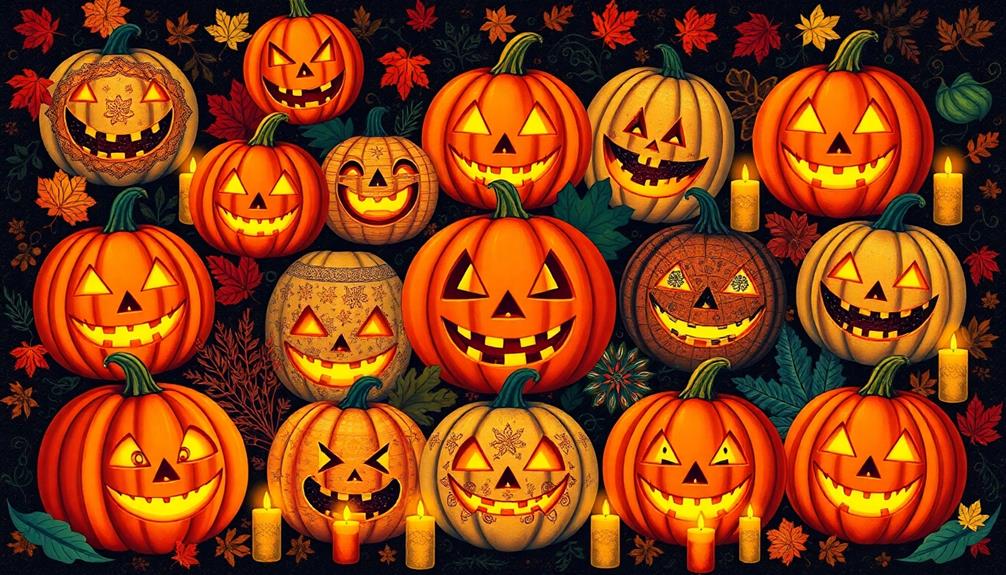
When you think about jack-o'-lanterns, consider how they connect to global lantern traditions that symbolize guidance and protection.
These glowing figures represent not just Halloween but also a universal theme of light overcoming darkness.
The concept of transformation, akin to the power of imagination, plays an essential role in how these symbols are celebrated across cultures.
As you explore their cultural significance, you'll see how they embody both ancient beliefs and modern celebrations.
Global Lantern Traditions
Lanterns have illuminated cultural celebrations across the globe, serving as powerful symbols of remembrance and hope. In the Irish folktale associated with the festival of Samhain, people carved turnips to ward off spirits, showcasing their belief in the protective power of light. This tradition is reminiscent of how dream symbols can provide insights into our subconscious beliefs and fears.
This global lantern tradition reflects a broader theme: the use of light in honoring the dead. In Japan, during the Obon festival, families light "toro" lanterns to guide their ancestors' spirits back home, reinforcing the cultural significance of these guiding lights.
Similarly, in Mexico, the Day of the Dead (Día de los Muertos) sees families creating vibrant altars adorned with candles, illuminating paths for loved ones to return, further emphasizing light's role in remembrance.
The Chinese Lantern Festival celebrates the first full moon of the lunar year, where colorful lanterns symbolize reunion and good fortune. Meanwhile, in India, Diwali, known as the Festival of Lights, uses oil lamps (diyas) to represent the victory of light over darkness.
Across these diverse cultures, global lantern traditions weave a rich tapestry of meaning, connecting people through shared values of remembrance and hope.
Symbolism of Light
Light holds profound symbolism across cultures, often representing hope, guidance, and protection. Here's how light plays a significant role in various traditions:
- Jack Trick the Devil: The legend of Stingy Jack reminds us that light can outsmart darkness.
- Light That Guides: Jack-o-lanterns serve as a beacon for wandering spirits, lighting their path.
- Ward Off Evil Spirits: During Samhain, lanterns illuminated the way for the deceased, creating a protective barrier against malevolent forces.
- Triumph of Light: The glow from jack-o-lanterns symbolizes the victory of light over darkness, embodying a universal desire for safety.
As you carve your pumpkin, think about how this simple act honors and remembers the dead.
The flickering candlelight inside your jack-o-lantern creates a warm ambiance, inviting both festivity and reflection.
You're not just decorating; you're participating in a rich tapestry of cultural significance.
This practice connects you with those who came before, reminding you that light can guide you through uncertainty, ward off evil spirits, and celebrate the triumph of light over darkness.
Embrace this tradition, and let your jack-o-lantern shine!
Competitions and World Records
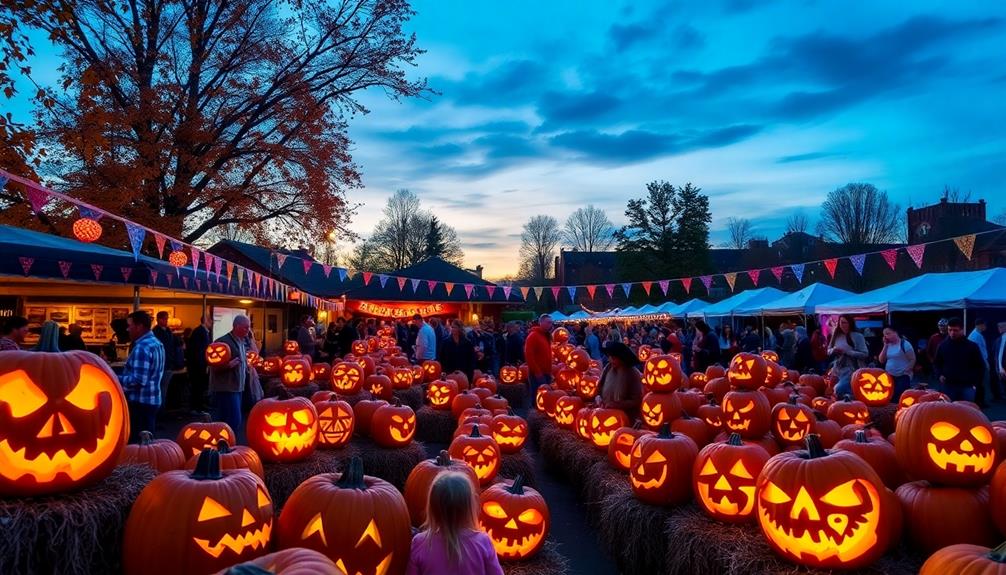
While pumpkin carving has long been a beloved Halloween tradition, competitions and world records elevate the art form to new heights. One of the most impressive feats occurred in Keene, New Hampshire, where a staggering 30,581 jack-o-lanterns were carved and lit on October 19, 2013. This record shattered the previous mark of 30,128 set in Boston, Massachusetts, just seven years earlier.
Competitions often celebrate creativity and craftsmanship in pumpkin carving, encouraging participants to showcase their skills. Events like the Great Jack O' Lantern Blaze in Sleepy Hollow feature thousands of hand-carved pumpkins, drawing crowds enthusiastic to appreciate the artistry.
Here's a quick look at notable records and competitions:
| Event | Location | Record/Highlight |
|---|---|---|
| Most Jack-o'-Lanterns | Keene, New Hampshire | 30,581 carved and lit (2013) |
| Previous Record | Boston, Massachusetts | 30,128 carved and lit (2006) |
| Great Jack O' Lantern Blaze | Sleepy Hollow, NY | Thousands of hand-carved pumpkins |
These competitions foster community engagement and pride, bringing neighborhoods together during Halloween festivities.
Modern Celebrations and Traditions

Modern Halloween celebrations prominently feature jack-o'-lanterns, blending ancient traditions with contemporary festivities that focus on community and creativity.
You'll find that making jack-o-lanterns at Halloween has become a cherished activity, and it's not just about carving pumpkins anymore. Here are some engaging events you might consider joining:
- Pumpkin Carving Contests – Showcase your skills and creativity alongside neighbors and friends.
- Local Festivals – Many pumpkin patches host seasonal events with hayrides and corn mazes.
- Community Engagement Activities – Participate in events like the Great Jack O Lantern Blaze, where thousands of intricately carved pumpkins create a stunning display.
- Online Sharing – Families now share their unique designs and carvings on social media, fostering inspiration and connection.
These modern Halloween celebrations emphasize not just the art of carving but also the importance of community bonding.
Even during the pandemic, adaptations like reduced capacity events guaranteed that people could still enjoy the spirit of Halloween while prioritizing safety.
Frequently Asked Questions
What Is the Significance of the Jack O Lantern?
The jack-o'-lantern's significance lies in its representation of Halloween's spirit. You carve it to ward off evil spirits, celebrate creativity, and foster community connections, making it an essential part of your festive traditions.
Where Did the Tradition of Jack O '- Lanterns Originated?
Did you know that about 1 billion pumpkins are harvested in the U.S. each year? The tradition of jack-o'-lanterns originated in rural Ireland, where families carved turnips to ward off evil spirits during Samhain.
What Was the Original Purpose of Most Jack O Lanterns?
The original purpose of jack-o'-lanterns was to ward off evil spirits. You'd carve them to symbolize light, protecting yourself from darkness and malevolent entities during festivals like Samhain, ensuring a safe and festive atmosphere.
What Is the History of Jack O Lanterns Samhain?
When it comes to Samhain, you'll find that jack-o-lanterns originated as carved turnips to ward off evil spirits. This tradition evolved in America, where pumpkins became the popular choice for Halloween festivities.
Conclusion
To summarize, jack-o'-lanterns light up our lives like stars in a night sky, connecting us to a rich tapestry of history and culture. From ancient Ireland to modern-day North America, these carved creations symbolize the blending of tradition and innovation. As you carve your own pumpkin, remember the stories and legends that have shaped this beloved practice. Embrace the joy and creativity that comes with each flickering candle, and keep the spirit of the jack-o'-lantern alive.
